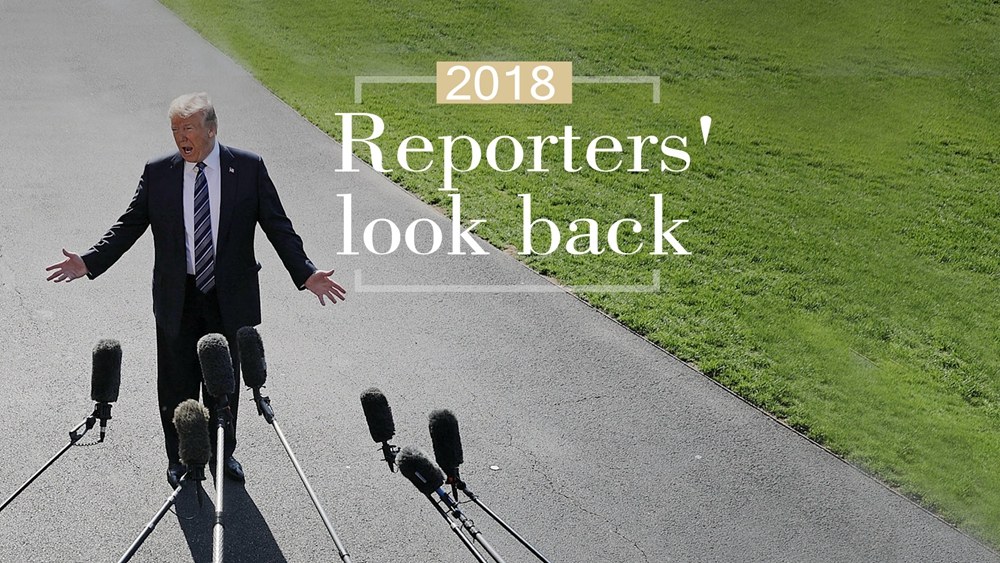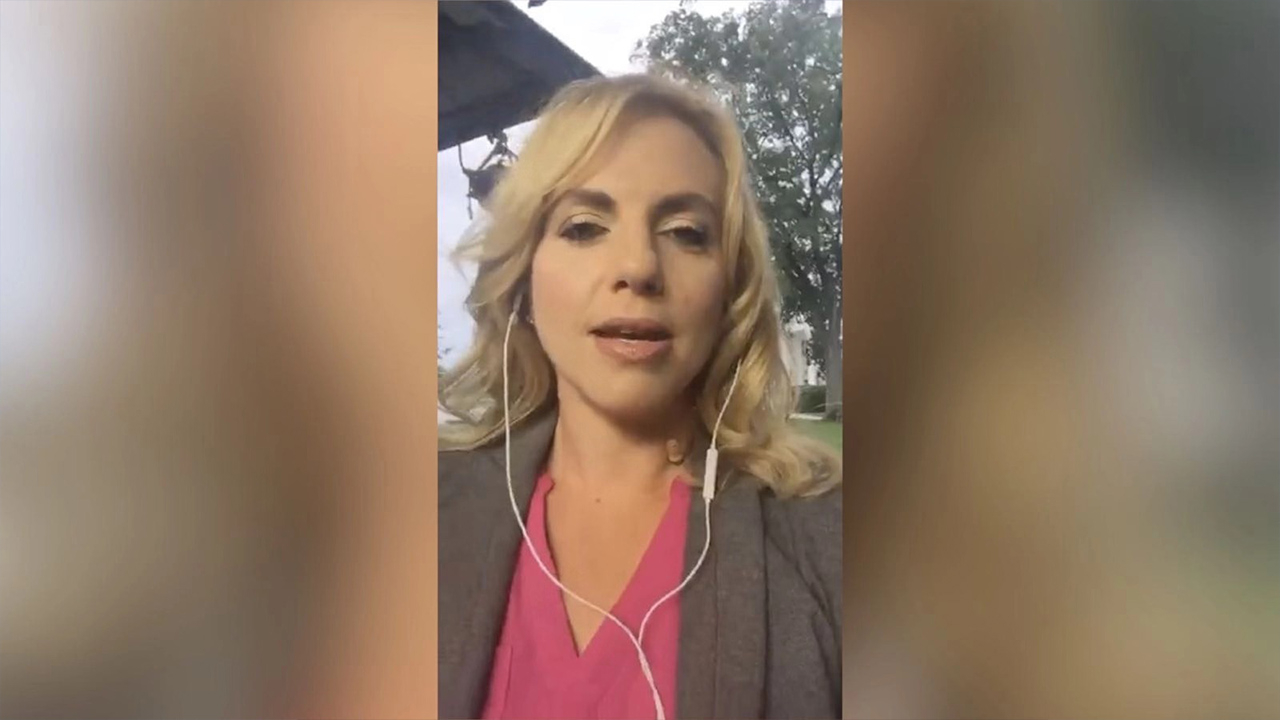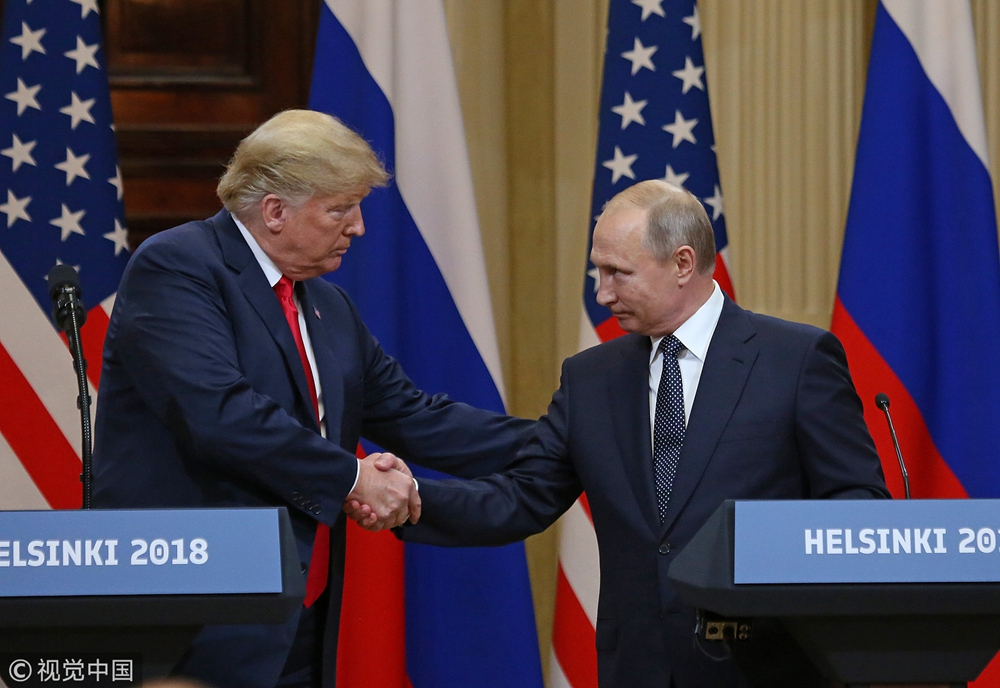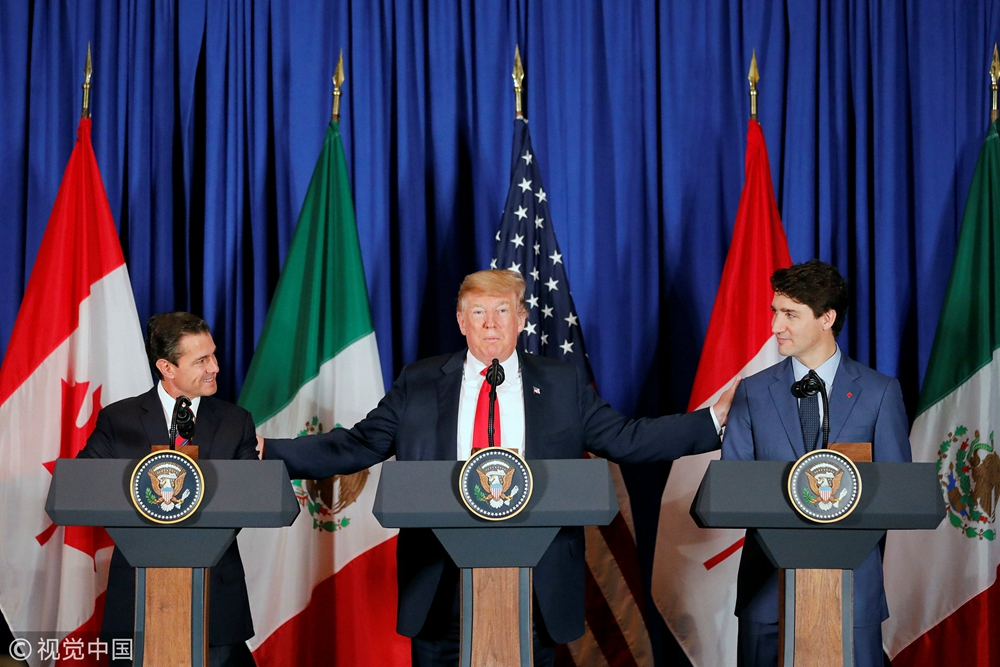
World
17:03, 31-Dec-2018
2018 Reporters' look back: A year of Trump's 'America First' diplomacy
Updated
16:18, 03-Jan-2019
By Jessica Stone

From boasting about the size of his "nuclear button" to alienating allies in North America and Europe to a "trade war" with China, U.S. President Donald Trump has taken the world on a roller coaster ride – pursuing what he calls "America First" policies in his first full year in office. As CGTN's White House correspondent, it has been an eventful year for me to say the least. Here's a recap of some of the events I followed and reported live from Washington.
'Straight to the top'
After bragging in January that his "nuclear button" was "much bigger" than the Democratic People's Republic of Korea (DPRK) leader Kim Jong Un's, Trump softened his tone. The two of them met face-to-face in June. Some progress followed.
02:43

The DPRK repatriated the remains of U.S. soldiers. It halted tests of missiles and nuclear bombs. But Pyongyang has yet to disclose the size of its weapons program.
In July, Trump held a summit with Russian President Vladimir Putin in Helsinki, Finland. The White House said it was a chance to re-open high-level communications between the leaders of two nuclear powers – severed after Moscow's 2014 annexation of Crimea. Former U.S. Ambassador to Russia Michael McFaul told the media that the absence of advisers in the room could give Putin "a tremendous advantage" over Trump.
McFaul might as well have had a crystal ball.
After the meeting, reporters asked Trump about Russia's alleged meddling in the 2016 election. Trump's response undermined U.S. intelligence agencies, which concluded that Moscow meddled in the presidential race.
"I have asked President Putin. He just said it's not Russia," replied Trump. "I will say this: I don't see any reason why it would be."

U.S. President Donald Trump (L) shakes hands with Russian President Vladimir Putin at the Presidential Palace in Helsinki, Finland, July 16, 2018. /VCG Photo
U.S. President Donald Trump (L) shakes hands with Russian President Vladimir Putin at the Presidential Palace in Helsinki, Finland, July 16, 2018. /VCG Photo
Condemnation was swift, including from his supporters.
Trump supporter, and former Speaker of the U.S. House of Representatives Newt Gingrich, tweeted: "It is the most serious mistake of his presidency and must be corrected immediately."
Trade battles
2018 was the year when the U.S.-China relationship got a lot more complicated. Trump launched, what many observers call, a “trade war” with America's largest trading partner.
Accusing China of “unfair trade practices,” Washington imposed tariffs on 34 billion U.S. dollars' worth of Chinese goods. That same day, July 6, China struck back. Beijing's tariffs mainly targeted U.S. commodities, including pork and soybeans. Washington tried to offset the losses for American farmers by offering 12 billion U.S. dollars in subsidies.
I went to Missouri, where Trump won an overwhelming victory in America's 2016 presidential election. Two of the state's top exports – pork and soybeans – were hit by Beijing's tariffs. I talked to farmers in cowboy hats and baseball caps whose livelihood hanged in the balance, yet they still chose to support the president.
August witnessed a second tranche of U.S. tariffs – on 16 billion U.S. dollars in Chinese products. China retaliated. Sixteen billion in U.S. imports were slapped by Beijing with a 25 percent tariff. In September, Washington released a list for 10 percent duties on an additional 200 billion U.S. dollars in Chinese imports. Nearly half the value of all Chinese goods imported to the U.S. in 2017 were now subject to higher taxes. The new tariffs began to weigh on American consumers and Chinese manufacturers.
02:34

One memorable anecdote I heard from the American side is this: even when these tariffs forced companies to move productions out of China, Americans will bring their Chinese partners with them. That's how closely intertwined these two supply chains economies are, especially when it comes to consumer goods.
"China just happens to do it in a cost effective way and deliver great quality," a U.S. trade group told me.
Ahead of his meeting with President Xi Jinping in Argentina, Trump repeated threats to impose the next round of tariffs on January 1, 2019, as scheduled. He also threatened to tax the balance of the Chinese exports to the U.S. – another 267 billion U.S. dollars in goods.
But after meeting in Buenos Aires, the leaders of the world's two largest economies called a truce. The U.S. agreed to put the January 1 tariffs on hold and postpone any new ones.
For 90 days starting December 1, the two sides will negotiate a range of issues, including market access and intellectual property protection.
On December 3, Beijing released a list of 38 punishments for intellectual property violations. Chinese companies face penalties starting this month.
Trump's feud with Europe isn't settled yet, either. In July, he said he reached an agreement with the President of the European Commission Jean-Claude Juncker to avert a U.S.-EU trade war. "We agree today to work toward zero tariffs," Trump said.
But Trump left open the possibility of hiking U.S. tariffs on European-made cars. A clash with Europe remains possible.
Closer to home, Trump imposed levies against Canada and Mexico as negotiators revised the North American Free Trade Agreement, or NAFTA. On October 1, the three parties agreed on a replacement – the United States Mexico Canada Agreement (USMCA).

U.S. President Donald Trump, Mexican President Enrique Pena Nieto and Canadian Prime Minister Justin Trudeau attend the USMCA signing ceremony in Buenos Aires, Argentina, November 30, 2018. /VCG Photo
U.S. President Donald Trump, Mexican President Enrique Pena Nieto and Canadian Prime Minister Justin Trudeau attend the USMCA signing ceremony in Buenos Aires, Argentina, November 30, 2018. /VCG Photo
The U.S. steel and aluminum tariffs that Canada called "unacceptable" and "an affront" remain in effect.
Domestic crises
At home, the Trump administration shed key players like national economic adviser Gary Cohn and Secretary of State Rex Tillerson. The White House also weathered tell-all exposés, including one by adult film star Stormy Daniels who says she had an affair with Trump.
Trump received sharp criticism for separating thousands of migrant children from their families at the U.S.-Mexico border. American television screens showed images of children sleeping in cages, triggering outrage.

A migrant travelling from Central America towards the United States shows a banner reading "No to the Wall" and showing a picture of U.S. President Donald Trump, November 10, 2018. /VCG Photo
A migrant travelling from Central America towards the United States shows a banner reading "No to the Wall" and showing a picture of U.S. President Donald Trump, November 10, 2018. /VCG Photo
September brought contentious Senate hearings to confirm Trump's Supreme Court nominee, Brett Kavanaugh. A former teenage acquaintance of Kavanaugh's accused him of an alleged sexual assault – decades after the fact. President Trump defended Kavanaugh.
2018's political calendar closed with American voters sending a loud message on Trump policies such as immigration and health care.
In November's midterm elections, Republicans strengthened their grip in the Senate, but opposition Democrats won back control of the House. Trump now faces major obstacles to his legislative agenda when the lower house of Congress – now controlled by Democrats – convenes in the new year.
(Top image: U.S. President Donald Trump speaks to the media before departing the White House, May 25, 2018. /VCG Photo)

SITEMAP
Copyright © 2018 CGTN. Beijing ICP prepared NO.16065310-3
Copyright © 2018 CGTN. Beijing ICP prepared NO.16065310-3